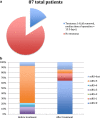Anti-N-methyl-D-aspartate receptor encephalitis: characteristics and rapid diagnostic approach in the emergency department
- PMID: 35717162
- PMCID: PMC9206331
- DOI: 10.1186/s12883-022-02752-9
Anti-N-methyl-D-aspartate receptor encephalitis: characteristics and rapid diagnostic approach in the emergency department
Abstract
Background: Anti-N-methyl-D-aspartate receptor (anti-NMDAR) encephalitis is a common type of autoimmune encephalitis. Patients with this condition are frequently very ill but are often misdiagnosed in the Emergency Department (ED). The objective of this study was to analyze the clinical characteristics of anti-NMDAR patients in the ED and to identify any associations with a diagnosis of anti-NMDAR encephalitis.
Methods: We performed a retrospective analysis of a prospectively obtained cohort of ED patients from May 2011 to December 2017. We identified patients diagnosed with anti-NMDAR encephalitis in this cohort and extracted key patient characteristics and clinical data, including patient gender, age, presentation, modified Rank Score (m-RS), laboratory test results, significant treatments, and mortality.
Results: Eighty-seven patients with anti-NMDAR encephalitis were identified. 54 (62.1%) were female, 23 (26.4%) were < 18 years old, 14 (16.1%) had teratoma, and 45 (51.7%) had an m-RS ≥ 4. Fever, altered mental status, and seizures were the most common symptoms, with a > 50% incidence of each symptom in the cohort. The sensitivity of CSF oligoclonal band (OB) testing was 78.9%. 22 (25.3%) were admitted to the ICU, 20 (23.0%) patients were intubated, but only one patient died (1.1%). 47 (54.0%) were misdiagnosed prior to ED arrival. All patients underwent immunotherapy as first-line treatment for anti-NMDAR encephalitis.
Conclusions: A majority of anti-NMDAR encephalitis patients presenting to the ED were female and were likely to be misdiagnosed prior to arrival. Patients with symptoms of fever, altered mental status, and seizures need a lumbar puncture, including CSF OB testing, for definitive diagnosis.
Keywords: Anti-N-Methyl-D-Aspartate Receptor Encephalitis; Diagnostic Errors; Emergency Department; Oligoclonal Bands; Teratoma.
© 2022. The Author(s).
Conflict of interest statement
The authors declare that they have no competing interests.
Figures


Similar articles
-
Anti-N-methyl-D-aspartate receptor (anti-NMDAR) encephalitis presenting to the emergency department with status epilepticus.CJEM. 2014 Sep;16(5):425-8. doi: 10.2310/8000.2013.131139. CJEM. 2014. PMID: 25227654
-
Surgical outcomes in patients with anti-N-methyl D-aspartate receptor encephalitis with ovarian teratoma.Am J Obstet Gynecol. 2019 Nov;221(5):485.e1-485.e10. doi: 10.1016/j.ajog.2019.05.026. Epub 2019 May 22. Am J Obstet Gynecol. 2019. PMID: 31128109
-
Anti-N-Methyl-d-Aspartate Receptor Encephalitis as an Unusual Cause of Altered Mental Status in the Emergency Department.J Emerg Med. 2016 Aug;51(2):136-9. doi: 10.1016/j.jemermed.2016.05.003. Epub 2016 Jun 11. J Emerg Med. 2016. PMID: 27301666
-
[Diagnosis and differential diagnosis of anti-N-methyl-D-aspartate receptor encephalitis in children].Zhongguo Dang Dai Er Ke Za Zhi. 2014 Jun;16(6):578-83. Zhongguo Dang Dai Er Ke Za Zhi. 2014. PMID: 24927431 Review. Chinese.
-
[Review of the psychiatric aspects of anti-NMDA (N-methyl-D-aspartic acid) receptor encephalitis, case report, and our plans for a future study].Neuropsychopharmacol Hung. 2016 Dec;18(4):199-208. Neuropsychopharmacol Hung. 2016. PMID: 28259863 Review. Hungarian.
Cited by
-
A juvenile mouse model of anti-N-methyl-D-aspartate receptor encephalitis by active immunization.Front Mol Neurosci. 2023 Sep 18;16:1211119. doi: 10.3389/fnmol.2023.1211119. eCollection 2023. Front Mol Neurosci. 2023. PMID: 37790883 Free PMC article.
-
Anti-NMDAR Autoimmune Encephalitis: A Diagnostic Challenge in Clinical Laboratories.EJIFCC. 2025 Jun 3;36(2):205-209. eCollection 2025 Jun. EJIFCC. 2025. PMID: 40584983 Free PMC article.
References
MeSH terms
Substances
LinkOut - more resources
Full Text Sources
Miscellaneous

